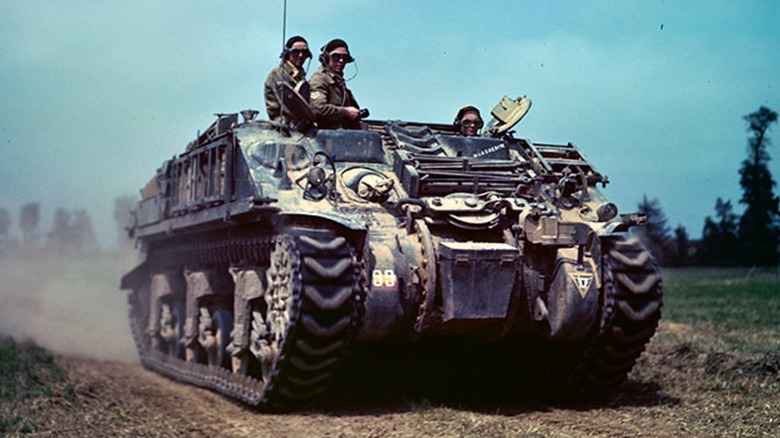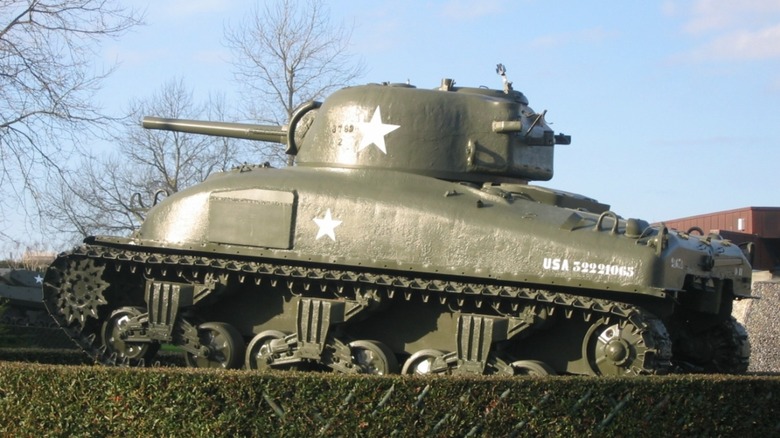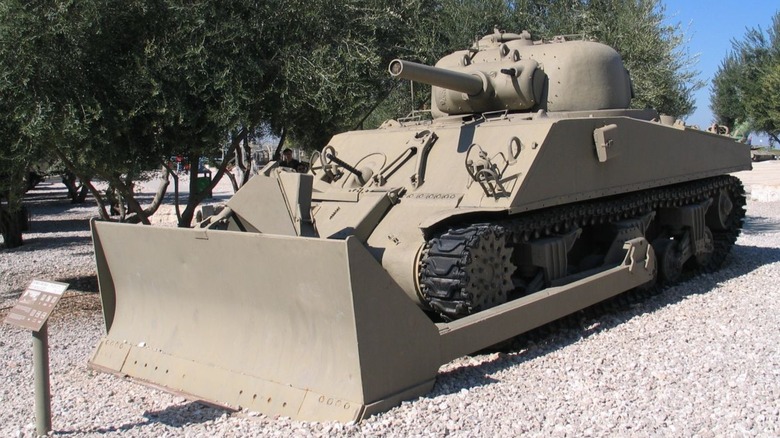How Many Variants Did The M4 Sherman Tank Have & Why Were There So Many?
While there were many pieces of impressive equipment developed and used throughout World War II, the United States' M4 Sherman remains one of the most legendary. The M4 was built by multiple companies that churned out nearly 50,000 of the deadly machines. Like most military equipment, the M4 didn't retain the same look and feel throughout its service life, as there were a considerable number of variants produced.
These were built using the chassis of the M4 for a variety of tasks, and the sheer number of variants is surprisingly high. While the M4 and its many variants were used to dominate the battlefields of WWII, the tank remained in service into the 21st century. Israel used them during the Yom Kippur War in 1973, and they remained in service in Paraguay until 2018. New tanks could be built to combat various threats, function in unusual environments, or carry out tasks that a conventional tank could not. Even the variants of the M4 have their own sub-variants, like the M4A3(75) and (105).
These sported a 75 mm and 105mm howitzer, respectively, that was used primarily for infantry support. Others include the M4A3E2 Assault Tank, nicknamed "Jumbo," thanks to its additional armor. If you count up all of the primary variants, there were 4, but when you factor in the additional sub-variants and derivative tanks, the number rises to 35. That's a lot of variety for a single tank to have. Still, many of the variants were used throughout the conflict in numerous engagements, and they all had their purposes.
The primary and variant models of the M4 Sherman tank
In the United States, which wasn't the only nation to use the M4, the tank was broken down into five primary models: the M4 (base model), M4A1, M4A2, M4A3, and M4A4. The M4 had many strengths and some weaknesses. A total of 6,281 M4A1s were produced, and these were primarily operated by the British. The British 8th Army first employed them during the Second Battle of El Alamein in Egypt in 1942. Americans also operated them during Operation Torch in North Africa.
The M4A2 was primarily used by the U.S. Marine Corps and the Soviet Union during World War II. The M4A3 was manufactured primarily for the U.S. Army, though the Marine Corps and other services operated them as well. These featured a 75mm main gun, a .50 caliber machine gun, and two .30 caliber machine guns. The Marines used eight M4A3s in Iwo Jima, Japan, all of which were modified with flamethrowers. As you might imagine, the Marines who operated them nicknamed the tanks "Zippos."
Of all the primary variants of the M4, the M4A3 and its sub-variant, the M4A3 76W, are considered to be some of the best. The M4A4 was a favorite of the British, and a total of 7,499 were produced between July 1942 and November 1943, which is mind-blowing given the length of time it takes to build much of anything today. The M4A4 was the heaviest and largest primary variant of the Sherman, which was due to the A57 motor that drove it.
Examples of the many sub-variants of the M4 Sherman tank
While there are too many M4 variants to detail here, some of the more interesting ones, like the pictured M4 outfitted with a 105 mm howitzer and the M1 dozer blade, are worth looking into. The Sherman Firefly is a variant of the M4 and M4A1, which the British rearmed with a 76.2mm main gun. These were operated by various nations, including Poland and Canada, while the British used them on D-Day.
The T34 "Calliope" was developed only in small numbers during WWII, but it packed a punch. It was outfitted with 60 launch tubes that fired 114 mm M8 rockets. Another interesting subvariant of the M4A3 was the M74 armored recovery vehicle. These were used in the 1960s to recover heavy armor and utilized a winch capable of lifting up to 132,400 lbs. It lacked a primary gun, but was outfitted with several machine guns for defensive purposes.
The M36 tank destroyer was a variant of the M4A3, which boasted a 90mm main gun capable of taking the fight to nearly any enemy armor on the battlefield. They were built late in the war and saw action in Korea in the 1950s. If you're a tank enthusiast, there's a place where you can not only see the interior of an M4 Sherman tank, but you can also drive one and shoot its cannon. This is possible at DriveTanks, located in Uvalde, Texas. It's not cheap, but it is definitely an experience any tank lover would appreciate.


